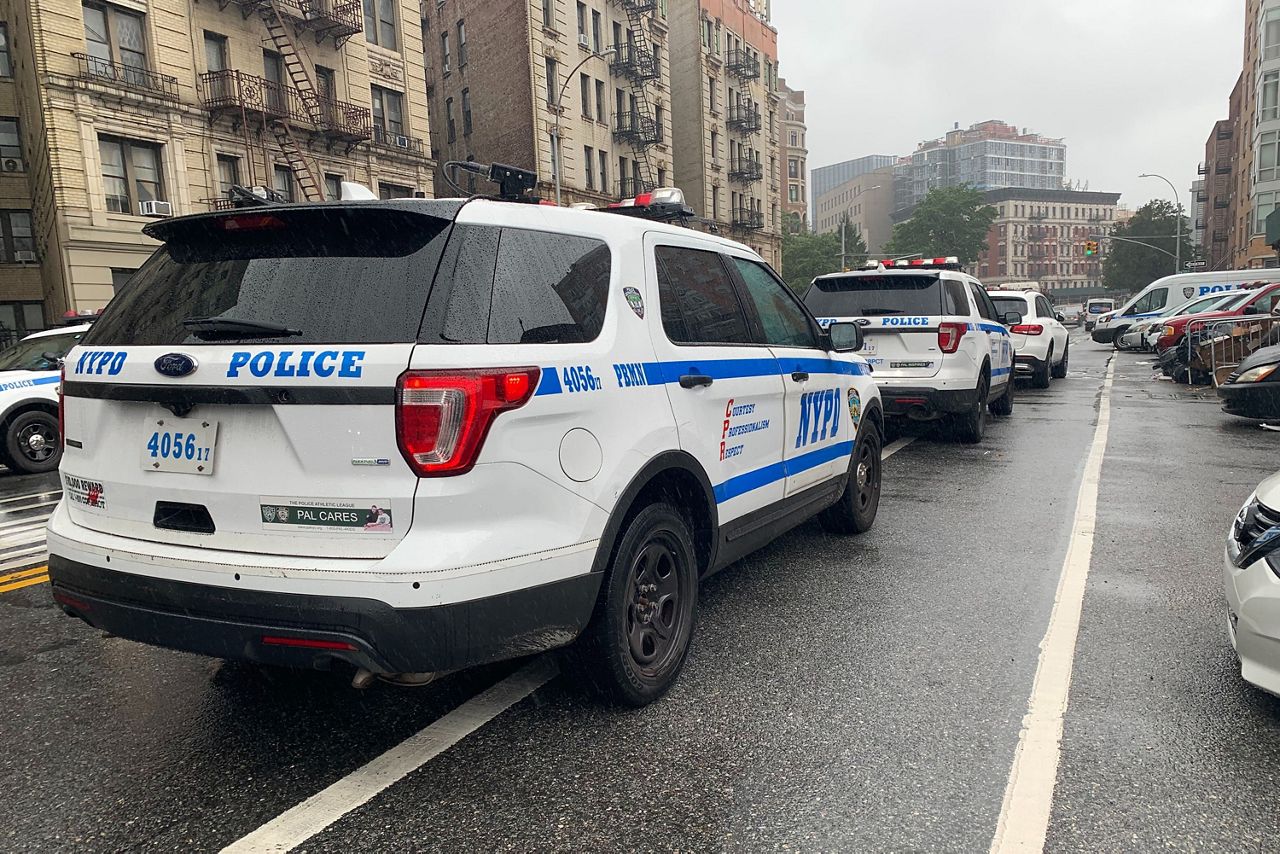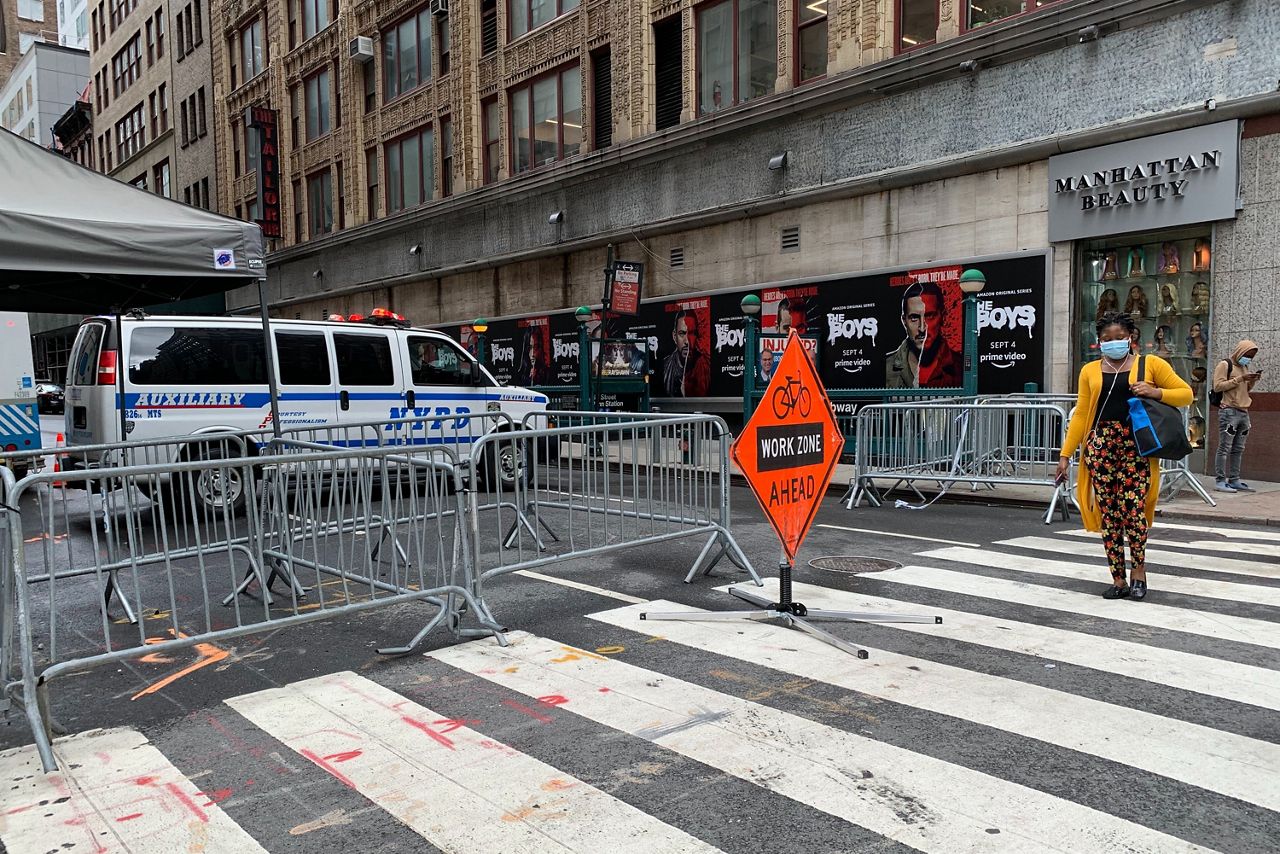The NYPD for months has blocked public access to streets and sidewalks outside police precincts in Manhattan, long after daily protests against police brutality have waned, a new review found.
Staff in the office of Manhattan Borough President Gale Brewer determined that 19 of the borough’s 22 police precincts had barricades fully or partially obstructing pedestrian or vehicular traffic — or both — to their blocks as of late July and early August.
An inspection of eight of the precincts by THE CITY on Wednesday confirmed that metal barriers remain in place near seven — while one, the 20th Precinct on the Upper West Side, recently reopened the street to vehicles.
In a letter sent Wednesday to NYPD Commissioner Dermot Shea, Brewer called for removing the remaining barricades except, when absolutely necessary — putting an end to what she described as a “siege mentality” during protests for racial justice.
“These barricades do block pedestrian and vehicular traffic at a time when public outdoor space is more vital than ever,” wrote Brewer, according to the letter, obtained by THE CITY. “They have also exacerbated the hardship felt by small businesses, forcing some to shutter their doors.”
The vast majority of barriers were erected around precincts in Manhattan, Brooklyn and The Bronx amid protests in late May and early June sparked by the repeated police killings of unarmed Black civilians, including George Floyd on May 25 in Minneapolis.
In the early days of the upheaval, a small number of precincts became the target of violence — among them the 88th Precinct in Clinton Hill, Brooklyn, according to published reports.
Police use of seemingly unprovoked force against peaceful protesters was also widely documented and derided, prompting an investigation by state Attorney Letitia James.
In its review of the fortifications, conducted between July 27 and Aug. 8, nearly two months after the height of the unrest, Brewer’s office found that nine Manhattan precincts were still blocking both pedestrian and car traffic. Two others blocked just vehicles, while one blocked pedestrians.
By that time, the remaining precincts either had partial barriers — including parked police vehicles blocking sidewalks — or no barriers, her office found.
‘A Domination-Type Thing’
On Wednesday, barricades were still in place at the Frederick Douglass Boulevard entrance to the 28th Precinct in Harlem, where police vehicles were parked in the bike lane behind the building on St. Nicholas Avenue.
“It’s like a domination-type thing,” said Jay Keiy, 40, of Harlem. “It’s their way of marking their area.”

The barricades jut into a sidewalk along Frederick Douglass Boulevard, where several personal police vehicles were parked in a space marked for “Authorized Vehicles Only.”
“They put them right on top of the sidewalk, crowding it for anyone walking by,” Keiy said. “There’s not a lot of respect for the people and their space.”
A few blocks north at the 26th Precinct, a marked police vehicle was parked alongside barricades that have been in place for months, blocking off West 126th Street where it meets Amsterdam Avenue.
Brewer’s report flagged the precinct, saying “public vehicles could not enter” at the intersection.
“I don’t see why they’re still here,” said Herman Brown, 63, a client at the St. Mary’s Center, a health care facility next to the precinct. “Everything has calmed down with the marches, but the only people that can drive through here are the police and I don’t think that’s right.”
But other regular visitors to the area said the fortress-like feel along that stretch of 126th Street has improved recently. At one point pedestrians were asked if they have business on the block.
“As time has gone on, it’s sort of eased back,” said Kenneth Williams, 68, another client at the St. Mary’s Center. “But at the beginning, it was a little hectic just trying to walk onto the block.”
Restrictions have largely lifted along West 82nd Street, where, for months, the block that is home to the 20th Precinct was barricaded at both ends, at Columbus Avenue and Amsterdam Avenue.
While the entrance to the precinct still has barricades in front of it, pedestrians and vehicles had full access to West 82nd Street during the Wednesday visit by THE CITY.
‘Nobody Walks Over Here’
Employees at a nail salon on East 51st Street — blocked to street and pedestrian traffic by the 17th Precinct — said the barricades have noticeably cut down on walk-in customers.
A worker at Tiffany Nail & Spa on East 51st Street said the business has been hit with a double whammy of few office workers in Midtown amid the pandemic, plus the security apparatus set up by police at the end of the block.
There, on Third Avenue, barricades prevent access to the sidewalk, and a police vehicle blocks street traffic next to a flag that reads, “NYPD Checkpoint.”
The worker said staffing at the nail spa has been cut from six to one, and that she often leaves before 4 p.m. because of the lack of clientele.
“Nobody walks over here,” the worker said.
The Midtown South and Midtown North precincts are also listed in Brewer’s report as among the 11 Manhattan stationhouses with barricades blocking vehicular traffic.

On West 35th Street on Wednesday, barricades were in place at Eighth Avenue and Ninth Avenue, with pedestrians allowed to enter the block that houses Midtown South — but the street remained off-limits to most vehicles. When THE CITY stopped by, an officer was posted by an NYPD van parked behind the barricades.
“Can I walk through here?” a teenage boy asked, before stepping beyond the barricades and onto the sidewalk.
NYPD officials didn’t respond to questions about the general security threat at precincts — or about the significant blockades still surrounding some of them.
Temporary Measures
Mayor Bill de Blasio has been questioned repeatedly about police closures of public streets, parks and other spaces in the aftermath of the protests — not just outside of precincts, but also in the vicinity of City Hall and his home at Gracie Mansion.
“We were dealing with a host of profound challenges and obviously distinct threats that were made, violent threats that were made that, unfortunately, there was a lot of evidence were very real,” he said of the security around precincts in mid-June, following a number of articles highlighting the issue. “So the actions taken in the midst of a crisis situation don’t reflect what we would do in everyday reality.”
As the security measures persisted into early August, the mayor emphasized that the barriers were in a limited number of places and for a limited time.
“There’s not a lot of barricades up in the bigger scheme of things,” he said on Aug. 6. “Around some police precincts where there had been challenges about safety and security. Some of that still exists, but again, that’s being modified over time,” the mayor added. “Everything we’re talking about is temporary and very limited in the city.”
Nearly a month later, however, barricades still lined the sidewalk near City Hall on Chambers Street on Wednesday — preventing access to the stairs of the Department of Education headquarters as two police officers stood guard nearby.
While City Hall Park was recently unlocked for the first time since June, the public plaza nearby that was the site of the Occupy City Hall protests is still largely blocked off with metal barricades and manned by two police officers.
And barricades outside of the Surrogate’s Court across the street from the DOE’s Tweed Courthouse headquarters that had been blocking the sidewalk have recently been moved out of the way to the curb. But three police officers remain stationed outside and on the corner of the building, which got heavily marked up with anti-police graffiti in July.
In her letter to Shea, Brewer acknowledged that legitimate safety concerns at some precincts would necessitate restricting access to an entire block.
“But in most cases I believe strongly that we can strike a more reasonable balance between the safety of officers and precincts and the concerns outlined above — and also help reduce the lingering traces of the ‘siege mentality’ that afflicted the city several months ago,” she wrote.
To sign up for this partner’s newsletter and have stories sent directly to your inbox, visit here.




